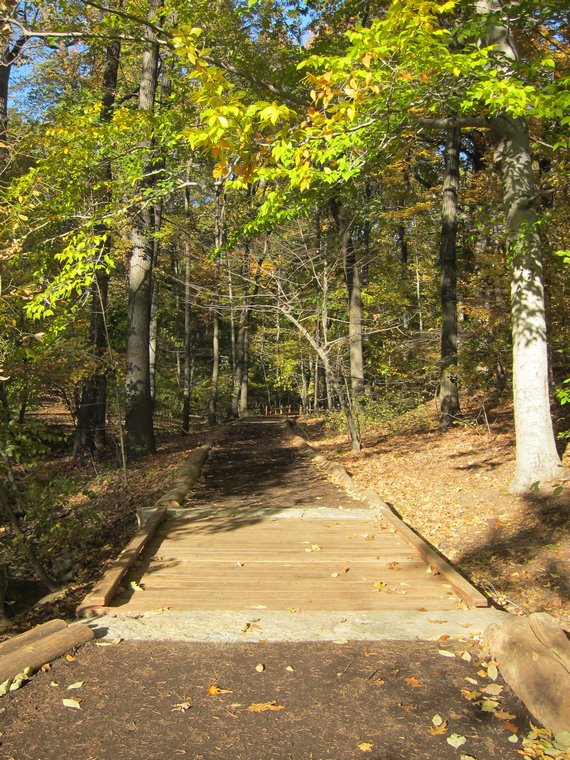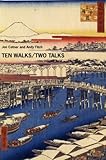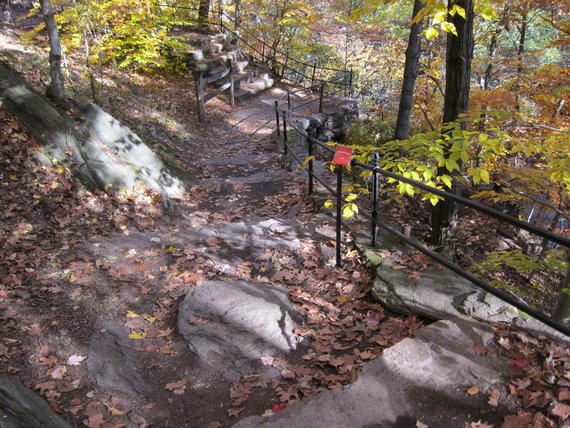
1.
My grandfather died two weeks ago, in his bed, by the sea in Maine. Two days earlier, perhaps with a little help from his morphine, he looked out his bay window and said: “I am going to run across that water.”
 I was reading Joan Didion’s Blue Nights at the time. On the aftermath of her daughter’s death, Didion writes: “‘Maintain momentum’ was the imperative that echoed … In fact I had no idea what would happen if I lost it.”
I was reading Joan Didion’s Blue Nights at the time. On the aftermath of her daughter’s death, Didion writes: “‘Maintain momentum’ was the imperative that echoed … In fact I had no idea what would happen if I lost it.”
The passage struck me. I, too, felt the drive toward momentum. Not wanting to stop and think about my grandfather’s death, mostly not wanting to feel it, I was looking for things to do. From the Poetry Society of America events calendar, I read that a young artist, Jon Cotner, had set up an installation in the woods called Poem Forest. The name alone intrigued me.
Just days after Grandpa died — I should maintain momentum, I told myself.
It had only been three weeks since our last conversation. We’d talked by phone. I was walking my dog. Grandpa would have been sitting at that bay window, where he always sat, too arthritic to move, looking out on the ocean. “You’re looking good, Rosie!” he said. It was a joke — obviously, by phone he couldn’t see me. I laughed. This was our shtick. “You’re looking good, too, Grandpa. Nice haircut.” He was bald. My childhood nickname was Rainbow Rose. Most everything we said to each other was based off familiarity, old jokes.
“Where are you now?” he wanted to know. “I’m on Broadway, Gramps!” I said, trying to speak over the sounds of traffic. “Where, honey?” “I’m on Broadway!”
Just an ordinary exchange.
How could he be gone?
How could I answer this question? I continued reading about Poem Forest, a self-guided, twenty-minute, walk through the woods. It was unusual. Cotner placed 15 numbered signposts along Sweetgum Trail at The New York Botanical Garden. He also provided handouts at the beginning of the walk that included 15 numbered lines as excerpts from 15 different poems. At each signpost, a walker was to stop and read the line of poetry that coordinated with that post. What was most interesting to me was the idea that, by reading such lines in various parts of the woods, participants would be able to “see and sense more clearly, to inhabit the present more deeply, and to fill with enchantment.” So relayed the event description.
Soon, I was yo-yoing between doubt and hope. I didn’t really think Poem Forest would make me feel better, but I convinced myself it could. It was the word “enchantment” that really did it for me, a tug toward the spiritual, what I took to be the possibility of a panacea.
A past professor put me in touch with Jon, who, in his emails, was eager to discuss the work. He told me he had just published a different walking piece in The Believer; it had involved an eight-mile trek across Fire Island with his fiancée, Claire Hamilton. They created a slideshow of the journey — she took the pictures, and he wrote the captions. From the link he provided in one of his emails, I watched a slideshow that moved like a graphic short story, an art form I particularly fancied.
The duo had also collaborated on a slideshow for the BMW Guggenheim Lab. To get an idea of what this project is like, take the outline from The Believer piece and replace Fire Island with Bedford Avenue, Brooklyn.
 Through our exchange, I also learned that Jon had co-authored a book with Andy Fitch called Ten Walks/Two Talks, consisting mainly of their conversations and resulting epiphanies as they engage with each other and New York City.
Through our exchange, I also learned that Jon had co-authored a book with Andy Fitch called Ten Walks/Two Talks, consisting mainly of their conversations and resulting epiphanies as they engage with each other and New York City.
All of Jon’s projects advocated connecting to your surroundings. The more we emailed, the more excited I became. It seemed oddly providential that our paths be crossing now.
I told Jon I had walked El Camino de Santiago, The Way of Saint James, a pilgrimage through Spain, and I wanted to understand how his outlook on walking related to mine. I’d always moved to avoid unwanted emotions, as a distraction, I told him. When I walked El Camino I was frustrated and sad. I did not want to cope with my pain. I wanted to steamroll right through it.
This can’t work, of course. But, oh how tempting it is to try.
2.
The next Saturday, I was standing at the bottom of Sweetgum Trail, waiting to meet Jon Cotner before beginning my walk. I was early, and a volunteer said Jon was finishing up some last minute trail maintenance. I didn’t mind waiting — above me, the sky cloudless. The air — perfect for November — neither warm enough to elicit anxiety in one’s inner environmentalist nor cold enough to cut the skin.
Soon, Jon was running down the trail.
We introduced ourselves, shook hands. He was exactly as I expected, poised. He was tall and stood with perfect posture, and was focused and concerned that each signpost on the path was properly angled, positioned just right. He was also polite and warm, excited about Poem Forest. How it allowed walkers to participate with the art, by moving through it.
“I look at this piece,” he said referring to Poem Forest, “as a perception primer.”
What, I wondered, would I perceive?
3.
I began, aware that though I was in one of the most beautiful parks in New York City, I was still, in fact, in New York City. Teenagers bounced off each other as they passed me. I passed a leaf-rubbing table for toddlers. The numbered signposts were laminated, and the flashes of plastic seemed out of place against the old wooden guardrails covered in moss and lichen. I encountered a woman painting a watercolor alone; the designer dog sitting beneath her bench was wearing a zebra-print coat. I sucked in my breath, tried to corner my scattered thoughts. I already wanted to be elsewhere — in Maine, with my family, where soon I would be.
This walk is meditative; it works, I struggled to convince myself, if I remember to focus on my breath. The interruptions shouldn’t matter as much as my focus. I tried to see clearly.
Fire-orange and red leaves were hanging from gray flaking branches, and the dark brown leaves on the ground crushed beneath my boots.
Signpost number three: The nature of yesterday / Is not nature. / What has been, is nothing.
What should have been a dreamy line of poetry felt insensitive, even mean. Thinking of Grandpa, I took it personally.
The air tasted clean. A crisp autumn breeze. I walked, hoping, not really believing, that something amazing would happen, something enchanting. Wouldn’t it be wonderful if it did?
The walk would have been lovely. There was nothing not beautiful about it. But that afternoon in the forest, I relearned an old lesson. There is no antidote to grief. There are only ways to cope.
My grief aside, I was still intrigued by what Poem Forest had to offer.

4.
I walked the trail again later that afternoon. This time with Jon. Part of the art, he said, is in the dialogue and in the thinking aloud.
I asked him something that was bothering me. Jon had called Poem Forest a perception primer. But what if there were things in this world you did not want to recognize?
Jon said he believed being here in the forest was greatly political. John Lennon and Yoko Ono’s Bed-In came to mind, the idea of advocating your beliefs by enacting them. Jon brought up Occupy Wall Street, his eyes refracting the colors of the leaves and the light that entered in glints: “Part of the trouble of our troubled times is a lack of perception.” Which could have been an academic response, a cop-out, except he immediately applied this philosophy to reality: “Did you notice, by the way, the [line of poetry] one stone is not like the other?” He motioned to the signpost by the river. “Did you notice the rocks around the riverbank?”
I hadn’t, but Jon pointed out the failed attempts to build a wall along the water’s edge. The rocks didn’t fit together, and the wall was eroding.
Then he said, “Isn’t it great to hear the rushing water? That it’s always making this sound?”
But my mind was still on the wall — and the probability that it would take me decades to work up to a perceptiveness as keen as Jon’s.
We continued talking and walking. Jon, with a mind like a library, quoted thinkers from Heraclitus to Frank O’Hara.
Regarding Poem Forest itself, the philosophy was quite simple. Jon said, “To some extent, this is an exercise in de-familiarization.”
Clearly, I was out of shape.
5.
After finishing our walk, we continued talking until it was time for me to catch the train back home (the dog would need walking). As Jon and I moved toward the elevated platform, we agreed that a lucid perception of your surroundings slows time. As opposed to how some people experience life, as Jon put it, “in a trance.”
I thought about Grandpa and — how quickly time goes. And then, I thought: I don’t want to live in a trance. I want to appreciate everything.
On the elevated platform, I tried to see it all: the train rattling closer, silver cars luminous in the sun. The air was getting cold. Inside the train: florescent light scattering rectangles along the glossy backs of plastic seats. There were people — everywhere. I felt crowded. My mind began to wander, already. Already? My head against the clammy seat, I was tempted: If I just close my eyes, maybe I will sleep. And if I sleep, I won’t have to think. And when I wake up, I will get off this train, and it will be as though no time has passed.
Except it will have.
So my eyes were open, and there I was, on a train that hadn’t even started moving.
Images: Claire Hamilton








